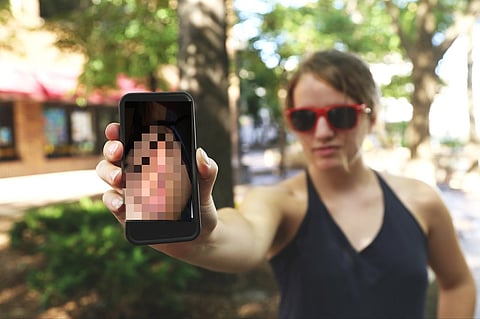

Sherrie Hewson, a TV presenter in the UK, recently revealed that after signing up for an online dating website she received an unexpected and unsolicited full-frontal image of her correspondent’s genitals. It’s something many women have experienced online and, although Hewson tried to make light of it she was left feeling shocked, and quit the site.
If you’re feeling brave (warning: graphic content), then take a look at ByeFelipe or visit Anna Gensler’s Instagram account for her artistic approach to dealing with the deluge of sexual suggestions and images she receives. Indeed, unsolicited “dick pics” have become such a problem on online dating services that one site, OkCupid, actually removed the capability to send images.
What would possess someone to send a graphic image of themselves without ever being asked for one, or even thinking to check if it might be appreciated?
When it comes to the internet, it seems common sense to think that the physical distance and anonymity the online world provides allows, even encourages, people to do things they wouldn’t normally do “in real life”. If you don’t believe your actions hold any consequences for you, then there is no fear of the social ramifications which might normally keep certain behaviours in check. John Suler called this the “online disinhibition effect”.
Put simply, if an online suitor can send an image of a disembodied penis to someone they don’t have to face, they are much more likely to do so than, for example, exposing themselves in public with all the social and legal consequences that might bring.
But this doesn’t explain the underlying motivations to send such images on a dating site. Do senders really hope to woo a potential date with the equipment on display? Well, according to some senders: yes. In a piece from online lifestyle magazine Refinery29, several of those men interviewed who had sent dick pics said they assumed women would want a nude image of them, because they would be more than happy to receive one from a woman.
Perhaps they should have taken note of a survey by Match.com which concluded receiving “sexts” is a turn off for women who use online dating – presumably because there is something very unsexy about ignoring the requirement to obtain consent first.
But to assume that these “misguided” attempts at seduction explain the rise and rise of such cyber-flashing tells only half the story. Misogynistic harassment is a serious issue for online dating services. Violent threats, hostile outbursts and being blackmailed into sending explicit images, are just some examples of the potential fall-out a woman might face – even for just ignoring or rebuffing a would-be suitor. The unwanted dick pic appears on this spectrum of behaviour.
A hypothesis I’m exploring concerns men’s responses to rejection on dating sites. Online dating offers dramatically wider opportunities to find and approach other singles. But this also means the scale of rejection may be amplified for someone who casts out many lines but receives few (or zero) bites. This particularly affects men, whom research shows initiate contact almost 80% of the time on dating sites.
Add to that the heightened amount of control that women have over online conversations (politeness norms can make it more difficult to assertively deflect romantic advances in face-to-face conversations, nudging women toward showing greater politeness than they might otherwise feel) and you have what social psychologists might call “a masculine identity threat”. In a culture where men are generally still expected to take the lead in sexual relationships, being denied all of these opportunities may make some men feel powerless in the online dating game and so turn to harassment or intimidation to try and re-establish a sense of power.
Consider the following story relayed to me during my research: my interviewee, after declining a man’s interest on a popular dating site, described receiving a message from him with a picture of an erection next to a kitchen knife. This disturbing juxtaposition suggests an intended reading of the penis as a weapon, with the ability to hurt or “punish” this woman for her apparent “transgression” by rejecting him. Quite clearly this person meant to frighten and intimidate her.
Some men even speak frankly about harassment as a motivation. In the Refinery 29 article, one person agreed that dick pics are a form of “lashing out … caused by being so thoroughly ignored by so many women.” A male participant from a study on young adults’ sexting was more unequivocal still, comparing those who send unwanted images with a “flasher in a raincoat”.
Flashing in public is illegal. In the UK, a conviction under the Sexual Offences Act 2003 can lead to a two year prison sentence. It’s not yet clear how the law might apply to the sending of unsolicited dick pics or sexual images, but British police have investigated at least one case. It’s essentially cyber-flashing, the real world’s online equivalent, and should be treated as seriously. There is no excuse for sexual harassment, online or offline.
Laura Thompson, PhD researcher, City University London
This article was originally published on The Conversation. Read the original article.